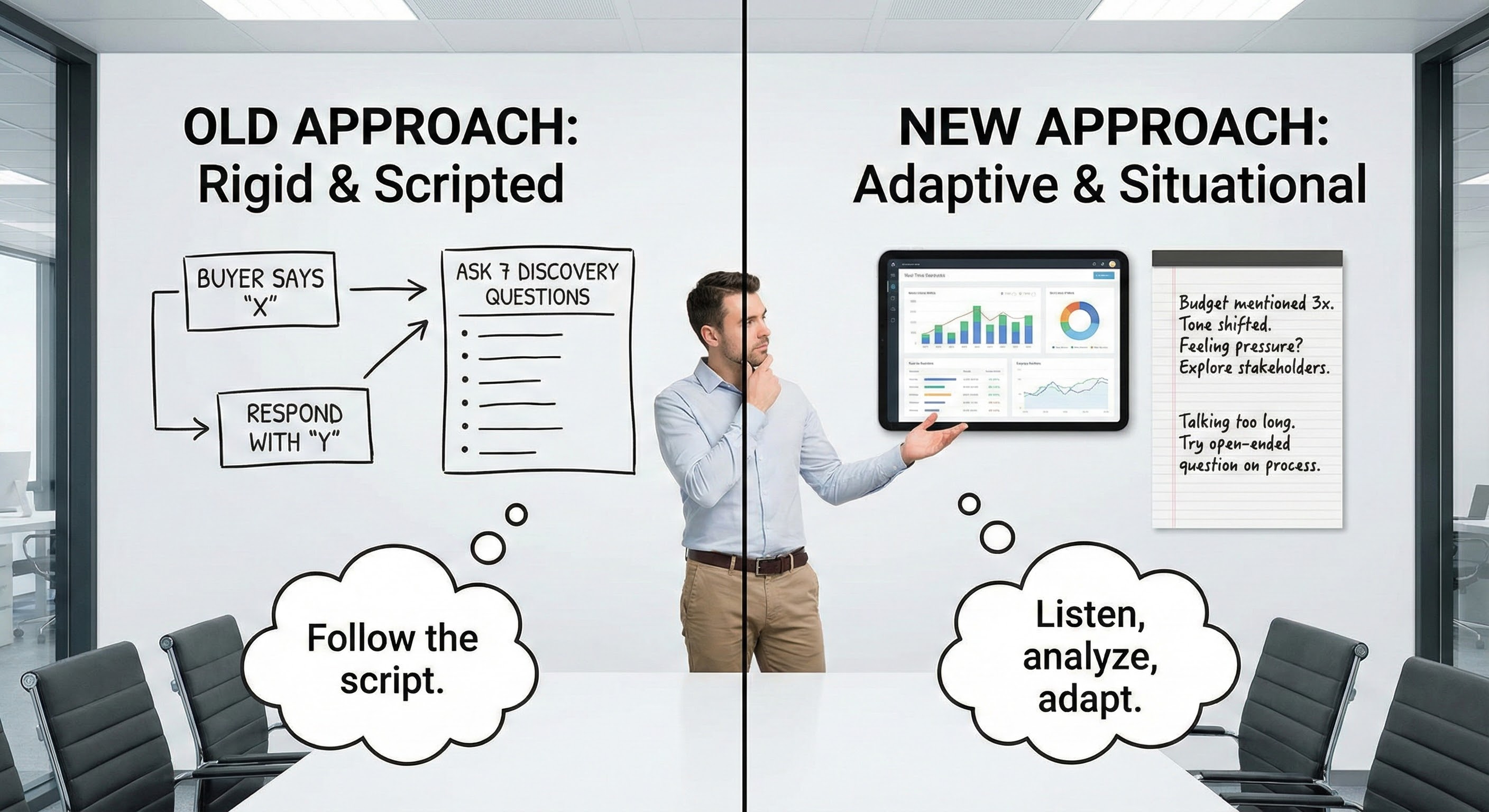From 45 Minutes to 5: How Agentic AI is Transforming Sales Call Preparation

Picture this: It's Monday morning, and you have five high-value prospect calls scheduled for the day. In the traditional sales world, you'd be looking at nearly four hours of preparation time – researching each company's recent developments, studying key stakeholders on LinkedIn, analyzing industry trends, and hunting for relevant conversation starters. By the time you finish preparing, half your day is gone before you've even picked up the phone.
This scenario is rapidly becoming obsolete. Agentic AI frameworks are transforming sales call preparation by automatically generating comprehensive prospect research, reducing preparation time from 45 minutes to just 5 minutes per call. This isn't just an incremental improvement – it's a fundamental transformation of how sales professionals approach prospect engagement.
Beyond Traditional AI: The Agentic Advantage

Agentic AI vs. Traditional LLM Prompting
To understand the revolutionary nature of this technology, it's important to distinguish agentic AI from traditional LLM prompting approaches. Traditional AI tools require sales professionals to manually gather data, craft specific prompts, and execute sequential queries across multiple platforms. This creates a human bottleneck where the salesperson essentially becomes a prompt engineer, spending valuable time figuring out how to extract insights from AI tools.
Agentic frameworks fundamentally change this dynamic by autonomously orchestrating complex research workflows through specialized AI agents working in parallel. Rather than requiring human intervention at each step, these frameworks deploy multiple AI agents simultaneously, each with specific expertise and objectives. This eliminates the human bottleneck of data collection and prompt engineering, allowing sales professionals to focus on what they do best: building relationships and closing deals.
The key difference lies in autonomy and orchestration. While traditional LLM prompting is reactive – responding to human-crafted queries – agentic AI is proactive, systematically exploring multiple research avenues without requiring detailed human guidance.
The Multi-Agent Research Revolution
Specialized Intelligence at Scale
The power of agentic AI lies in its ability to deploy specialized agents simultaneously, each focused on a specific aspect of prospect research:
The Company Intelligence Agent serves as your dedicated business analyst, diving deep into financial reports, earnings calls, SEC filings, and recent news coverage. This agent doesn't just collect surface-level information – it analyzes business performance trends, identifies strategic priorities, and flags recent developments that could impact purchasing decisions. Within minutes, it can synthesize quarterly earnings discussions, merger announcements, and executive strategy statements into actionable insights.
The Contact Research Agent functions as your personal network intelligence specialist, analyzing LinkedIn profiles, professional networks, and career trajectories of key stakeholders. This agent maps organizational relationships, identifies mutual connections, discovers shared interests or backgrounds, and analyzes communication preferences based on public professional activity. It goes beyond basic contact information to understand the human dynamics that influence decision-making.
The Industry Analysis Agent operates as your market intelligence advisor, continuously monitoring industry trends, competitive landscape shifts, and regulatory changes that affect your prospects' sectors. This agent identifies market pressures, emerging opportunities, and competitive threats that your prospects are likely facing, enabling you to position your solutions within the broader context of industry challenges.
The Buying Signal Agent works as your opportunity detector, monitoring funding announcements, expansion indicators, leadership changes, and other trigger events that suggest active buying intent. This agent doesn't just identify what's happening – it analyzes the implications and timing of these signals to help prioritize prospects and customize approach strategies.
Automated Excellence: Research Output That Delivers
From Data to Actionable Intelligence
The system automatically generates personalized cheat sheets that transform raw data into strategic sales intelligence. These aren't generic company profiles – they're customized research briefs tailored to your specific solution and sales approach.
Executive summaries of business priorities provide a clear understanding of what matters most to your prospect's leadership team right now. Instead of guessing about their strategic focus, you enter conversations with concrete insights about their declared objectives and challenges.
Relevant case studies are automatically matched to your prospect's industry, company size, and specific challenges, eliminating the guesswork about which success stories will resonate most strongly during your conversation.
Conversation starters go beyond generic icebreakers to include specific, relevant discussion points based on recent company developments, industry trends, or stakeholder interests that create immediate engagement and demonstrate preparation.
Potential objections are anticipated based on company characteristics, industry patterns, and competitive landscape analysis, allowing you to prepare thoughtful responses rather than being caught off-guard during crucial moments.
Key stakeholder profiles provide insights into decision-makers' backgrounds, priorities, and communication preferences, enabling you to adapt your approach to resonate with each individual's perspective and concerns.
All of this intelligence is delivered within minutes of inputting a prospect's name, creating a research capability that would have required a dedicated analyst and hours of manual work just a few years ago.
The Transformation Impact
Redefining Sales Productivity
The impact extends far beyond time savings, though the efficiency gains alone are remarkable. Sales professionals no longer spend 45 minutes manually navigating websites, LinkedIn profiles, and industry reports for each prospect. Instead, they receive AI-generated insights that would have taken hours to compile manually, enabling more calls per day while maintaining higher-quality prospect interactions.
This transformation creates a compound effect on sales performance. When preparation time drops from 45 minutes to 5 minutes, sales professionals can engage with significantly more prospects without sacrificing interaction quality. The math is compelling: what previously allowed for perhaps 3-4 well-researched calls per day now enables 8-10 interactions with the same or better preparation quality.
More importantly, the quality of these interactions improves dramatically. When sales professionals enter conversations armed with comprehensive, current intelligence about their prospects' business priorities, industry challenges, and stakeholder dynamics, they can engage at a strategic level from the very first moment. This positions them as trusted advisors rather than generic vendors, fundamentally changing the trajectory of sales conversations.
The technology also levels the playing field between experienced and newer sales professionals. Junior team members gain immediate access to research capabilities that previously required years of experience to develop, while seasoned professionals can focus their expertise on relationship building and strategic selling rather than information gathering.
The Future of Sales Preparation

Beyond Research: Predictive Preparation
As agentic AI frameworks continue to evolve, we can expect even more sophisticated preparation capabilities. Future systems will likely provide predictive insights about optimal timing for outreach, suggest personalized value propositions based on stakeholder analysis, and even recommend specific conversation flows based on successful patterns from similar prospects.
The organizations embracing this technology today are positioning themselves for sustained competitive advantage. They're not just improving efficiency – they're enabling their sales teams to engage at a higher strategic level with every prospect, building the kind of consultative relationships that drive long-term revenue growth.
The shift from manual research to agentic AI preparation represents more than technological advancement; it's a fundamental reimagining of how sales professionals invest their time and energy. By eliminating the research bottleneck, this technology allows sales teams to focus on what matters most: building relationships, solving problems, and creating value for their prospects.







